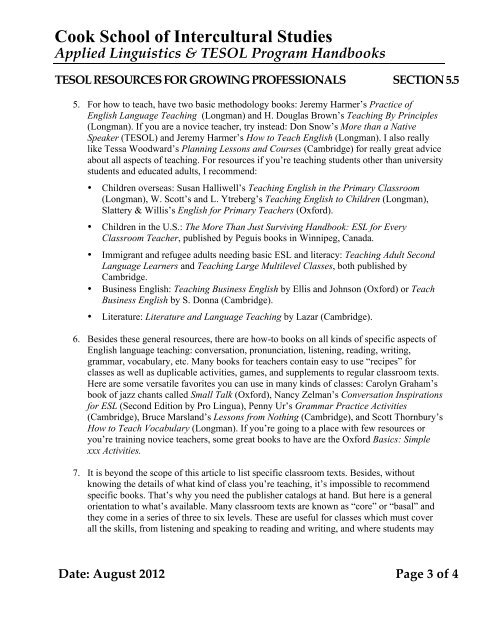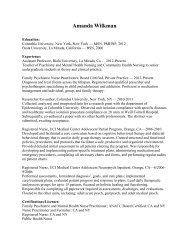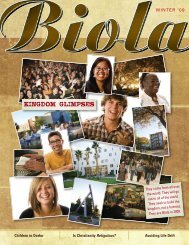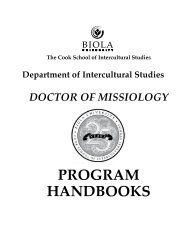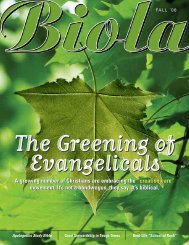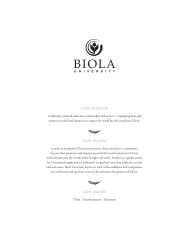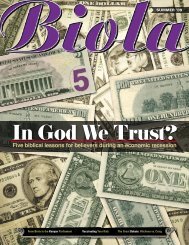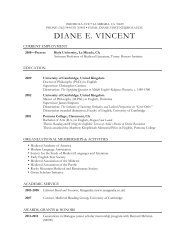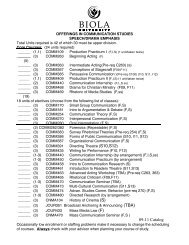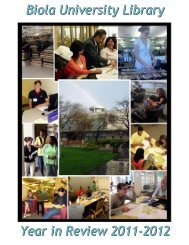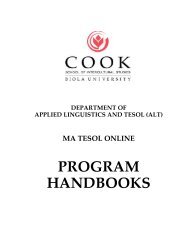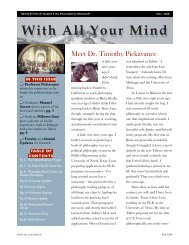PROGRAM HANDBOOKS - Biola University
PROGRAM HANDBOOKS - Biola University
PROGRAM HANDBOOKS - Biola University
You also want an ePaper? Increase the reach of your titles
YUMPU automatically turns print PDFs into web optimized ePapers that Google loves.
Cook School of Intercultural Studies<br />
Applied Linguistics & TESOL Program Handbooks<br />
TESOL RESOURCES FOR GROWING PROFESSIONALS SECTION 5.5<br />
5. For how to teach, have two basic methodology books: Jeremy Harmer’s Practice of<br />
English Language Teaching (Longman) and H. Douglas Brown’s Teaching By Principles<br />
(Longman). If you are a novice teacher, try instead: Don Snow’s More than a Native<br />
Speaker (TESOL) and Jeremy Harmer’s How to Teach English (Longman). I also really<br />
like Tessa Woodward’s Planning Lessons and Courses (Cambridge) for really great advice<br />
about all aspects of teaching. For resources if you’re teaching students other than university<br />
students and educated adults, I recommend:<br />
• Children overseas: Susan Halliwell’s Teaching English in the Primary Classroom<br />
(Longman), W. Scott’s and L. Ytreberg’s Teaching English to Children (Longman),<br />
Slattery & Willis’s English for Primary Teachers (Oxford).<br />
• Children in the U.S.: The More Than Just Surviving Handbook: ESL for Every<br />
Classroom Teacher, published by Peguis books in Winnipeg, Canada.<br />
• Immigrant and refugee adults needing basic ESL and literacy: Teaching Adult Second<br />
Language Learners and Teaching Large Multilevel Classes, both published by<br />
Cambridge.<br />
• Business English: Teaching Business English by Ellis and Johnson (Oxford) or Teach<br />
Business English by S. Donna (Cambridge).<br />
• Literature: Literature and Language Teaching by Lazar (Cambridge).<br />
6. Besides these general resources, there are how-to books on all kinds of specific aspects of<br />
English language teaching: conversation, pronunciation, listening, reading, writing,<br />
grammar, vocabulary, etc. Many books for teachers contain easy to use “recipes” for<br />
classes as well as duplicable activities, games, and supplements to regular classroom texts.<br />
Here are some versatile favorites you can use in many kinds of classes: Carolyn Graham’s<br />
book of jazz chants called Small Talk (Oxford), Nancy Zelman’s Conversation Inspirations<br />
for ESL (Second Edition by Pro Lingua), Penny Ur’s Grammar Practice Activities<br />
(Cambridge), Bruce Marsland’s Lessons from Nothing (Cambridge), and Scott Thornbury’s<br />
How to Teach Vocabulary (Longman). If you’re going to a place with few resources or<br />
you’re training novice teachers, some great books to have are the Oxford Basics: Simple<br />
xxx Activities.<br />
7. It is beyond the scope of this article to list specific classroom texts. Besides, without<br />
knowing the details of what kind of class you’re teaching, it’s impossible to recommend<br />
specific books. That’s why you need the publisher catalogs at hand. But here is a general<br />
orientation to what’s available. Many classroom texts are known as “core” or “basal” and<br />
they come in a series of three to six levels. These are useful for classes which must cover<br />
all the skills, from listening and speaking to reading and writing, and where students may<br />
Date: August 2012 Page 3 of 4


